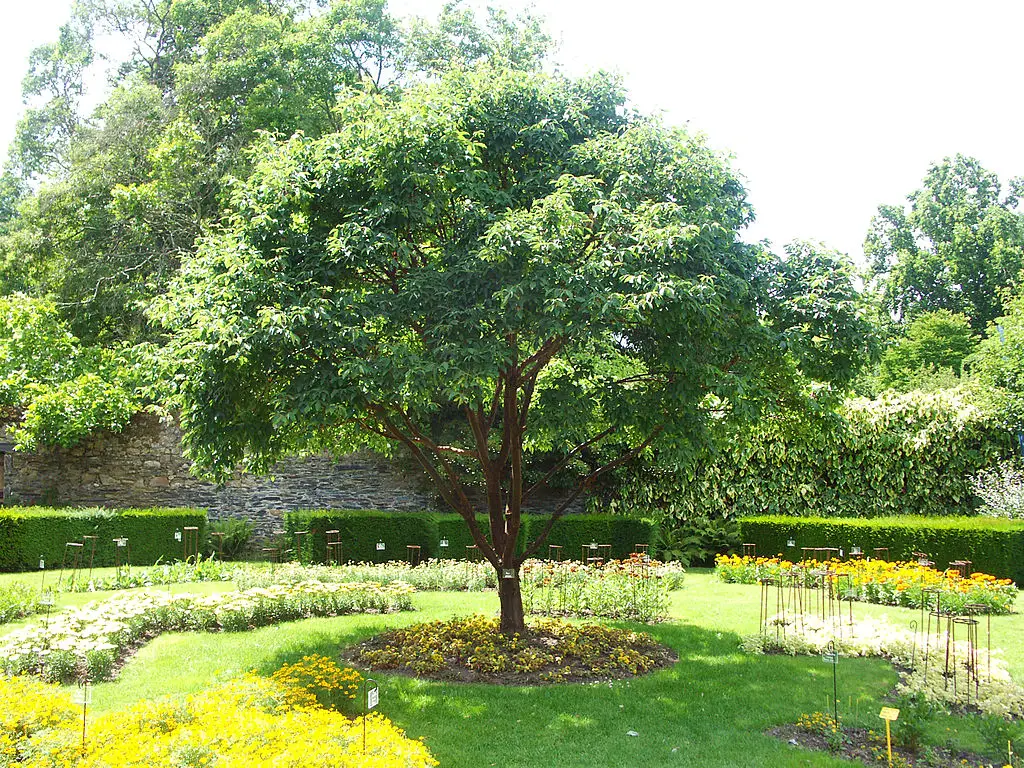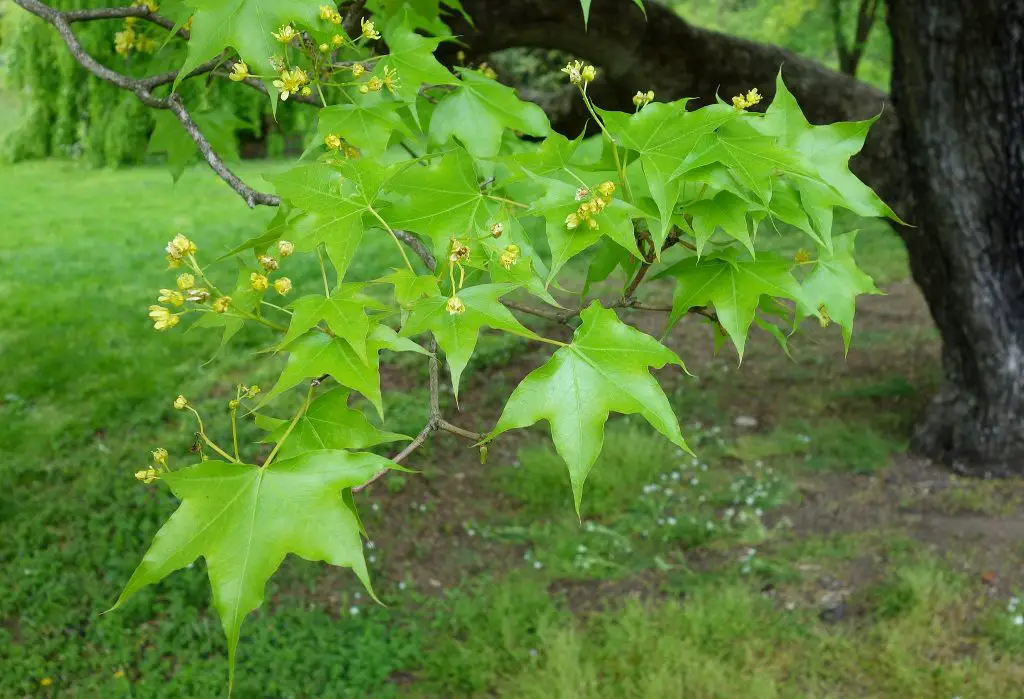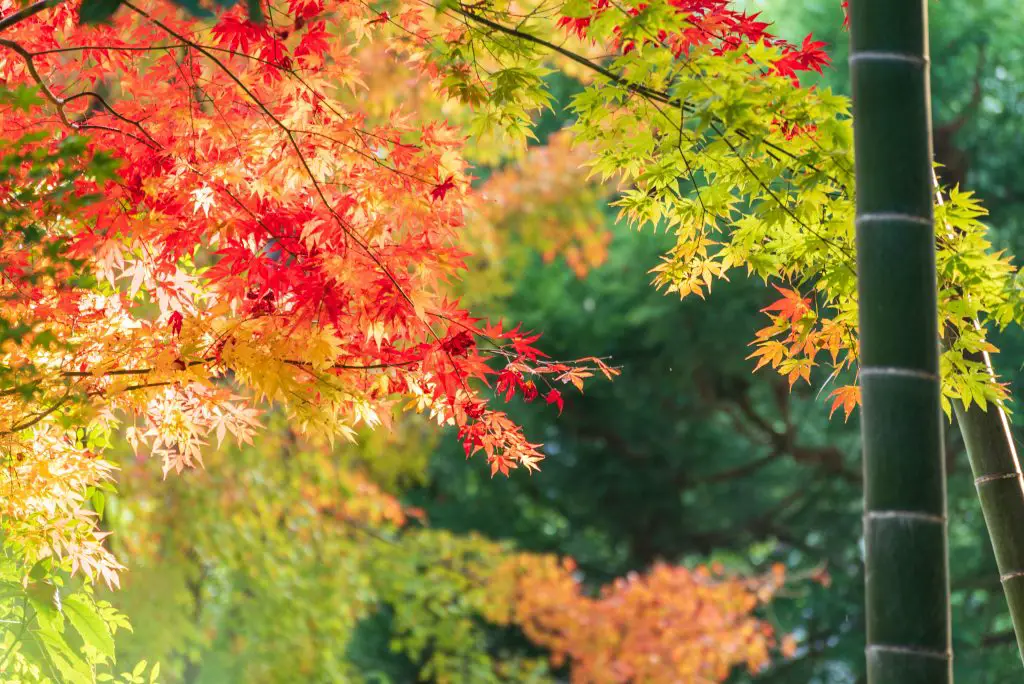What Is A Chinese Maple? Maple trees, which are the common name for species from the Acer genus, contain 132 species that are spread throughout Asia, North America, and some parts of Europe. Among these species, the most well-known to home gardeners is the Japanese maple varieties which are relatively small trees that are useful in domestic settings.
The other very well-known group of trees in this genus is the Canadian Maples which are generally much larger trees that are native to the northern parts of the US and Canada. A far less well-known group of plants is the Chinese maples, so how do they differ from better-known cousins?
The term Chinese maple tends to most commonly refers to the species Acer griseum (the Chinese paperbark maple) and to a lesser degree this term can also apply to Acer truncatum (Chinese Shandong maple). Both plants are similar in size to common Japanese maple varieties though the Shandong maple can get a bit bigger over time. Both trees plants have the characteristic maple leaf shape and produce bright red and orange colors in late autumn or early winter.
However, the Chinese paperbark maple has distinctive reddish-brown bark that the tree sheds over time, a photograph of this is shown below. Whereas the Chinese Shandong maple has a smooth bark on young trees that developed shallow ridges as the tree ages. Both plants are quite slower growers only adding a few inches a year in height.

About The Chinese Paper Bark Maple
Chinese Paper Bark Maple is known for its exfoliating bark and colorful autumn displays. The chestnut bark of both the trunk and branches constantly peels a thin layer off revealing a bright cinnamon-colored truck underneath.
The tree itself is a moderately sized spreading deciduous tree that grows up to 20-30 ft (6-9 m) tall and width 15-25 ft (4.5-7.5m). It performs well in full sun or partial shade in moist, well-drained soils but it is intolerant of drought.
The leaves consist of three lobes that are dark green in spring and summer, before turning bright red and orange in autumn.
Ideal for use in small gardens in zones 4 to 8 as it is moderate in size and slow-growing but provides interest year-round. It is also low maintenance.

About The Chinese Shandong Maple
The Chinese Shandong Maple is a medium-sized deciduous tree that reaches up to 45 ft (15 meters) tall. The bark on young trees, as mentioned above is a smooth greenish-gray color that becomes ribbed with age.
The leaves are a little smaller than Canadian maples, typically 2 to 4.5 inches in length. and they have five-lobed configuration. Additionally, the plant produces small yellow-green flowers in early spring. See the image below.

This plant is less distinctive than the Chinese Paper Bark Maple and is often confused with other closely related species such as Acer amplum and Acer cappadocicum.
The tree is hardy down to zone 6 and prefers well-drained soil that is neutral to slightly acidic. It can tolerate semi-shade prefers a sunny location. There are a number of varieties available with the most common ones being “Akikaze Nishiki” and “Fire Dragon”.
Growing Maple Trees
Irrespective of the size of property you have there will be a maple tree that suits your needs. They are ideal trees for providing shade during the hot summer months and they provide a range of splendid colors in the fall. The most popular varieties are sugar maple, silver maple, red maple, and Japanese maple.
Maple trees can be grown from seeds however it is most common for people to purchase young trees from the local garden center. However, if you are wanting to grow the plants from seed it is important to ensure that the seeds do not dry the seeds, otherwise, they will die.
To germinate the seedlings the most common method used involves cold stratification which basically means that the seeds are subjected to both cold and moist conditions which stimulate the seeds to germinate. To create this environment artificially Put a mixture of vermiculite, peat moss, or even sawdust into a releasable zip lock bag.
Add a few drops of water to moisten the mixture ensuring that it is damp but not wet. The best way to ensure that the growing medium has the ideal moisture content is to squeeze out excess liquid.

Once the mixture has been prepared place the maple seeds in the center of the mixture and seal the bag. Place it into a refrigerator for 90-120 days. As fungus can thrive in these conditions it is important to check the bag and remove any fungus as this is the biggest problem when growing maple from seeds.
Once the seeds have sprouted, they should be transferred to pots. These pots should ideally be grown in a warm location that gets plenty of sunlight. The following spring once the tree has begun to sprout it can be planted out after the last frosts in your area.
However, when planting out the potted trees it is important to not plant any later than mid to late summer as it will not allow the tree enough time to develop its root system prior to winter.
When transplanting maple, choose a sunny place where you want the tree to grow. It is generally a good idea to avoid planting the tree too close to the driveway or sidewalk as the large, solid roots on the surface are able to crack roadways and sidewalks over time.
The soil conditions at the planting site should be neutral or slightly acidic. The ideal pH is 6.0 to 7.0, for more information on the effect of pH and how to measure it click here.
Dig a planting hole that 4 times the size of the root ball and 4 times deeper. To the base of the hole add compost to ensure that the tree has plenty of nutrients. Place the plant into the hole ensuring that the top of the root ball is level; with the surface of the soil.

Backfill the hole with the soil firming it in with your heel to ensure that the soil compacted and there are no air pockets. Water the young tree thoroughly and apply extra water for the first few weeks, but only if conditions are dry and there is little rain. To suppress weeds and create a neat appearance, apply a layer of mulch around the trunk.
In the first season after transplantation, the trees need to be watered as their root system is yet to be fully established. However, after that time they will generally not require additional water or maintenance.
However, it is advisable to prune the trees in the winter and remove shoots, dead and diseased branches. When making cuts ensure that they are close to the trunk or branches.
Related Articles
12 Tips To Boost Your Garden Output
10 Ways To Make Your Vegetable Garden Look Beautiful
7 Easy Steps To Creating An Orchard In Your Own Yard
How To Prevent Weeds From growing
